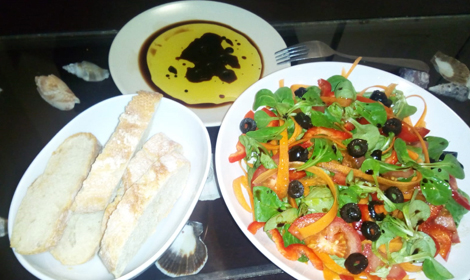
Making Olive Oil In Greece – No Pressing Allowed
I love olive oil: drizzled over a crunchy salad; puddled with balsamic vinegar and mopped up with fresh bread; infused with chillies and dribbled over pizza in place of cheese. And as if that’s not enough to recommend this delicious oil – it’s healthy too!
I had always assumed the olives were pressed in order to extract the oil – after all that’s what all the bottles on the supermarket shelf say; cold pressed extra virgin olive oil. But, as I discovered during a tour of the Kyklopas Olive Oil Estate in Makri, Northern Greece, that this is no longer the case.

The Kelidou family has been harvesting olives since the 1950s and in the 80s opened a small factory to process their harvest into premium oils.
With over 14,000 olive trees (2000 of which are grown 100% organically) they bottle over 70tonnes of oil per year.
The olives are harvested from October by shaking the trees and allowing the fruit to fall onto ‘carpets’ spread across the ground below.
These olives are taken to the small factory on site where the leaves are removed using, what amounts to, a giant hairdryer which blows them off. The olives are then washed, and if the oil is to be flavoured with garlic, lemon, orange or chillies then these are added at this stage.
The clean olives (and the added if flavours if appropriate) and moved to a machine a bit like a giant food processor that churns the them into a paste. The process is actually quite gentle as the stones are still inside the olives. It is important that the stones remain whole and are not broken or crushed – otherwise they will be impossible to remove.
The paste then undergoes malaxation; water is slowly stirred into the paste, allowing the tiny oil molecules to clump together and concentrate. This mixture is stirred for 20 to 40 minutes before being spun with centrifugal force separating out the oil, stones and natural water content. By heating the paste it’s possible to get more oil out of it, but it also degrades the oil reducing its flavour and nutrient density. So good quality oils are not heated – hence the term ‘cold pressed’.

Traditionally the paste was indeed pressed, but it can be tricky to clean the presses which eventually got clogged with old oil, so today most producers use the centrifugal process as this is much more hygienic.
The separated oil is next filtered through paper-lined metal filters that are turned to allow the oil, but nothing else, through.
This final oil is then bottled, and each bottle is checked by hand, in front of a light, to ensure that no ‘bits’ are in the oil and that the colour and quality is correct.
The stones that have been extracted are used as fuel for the factory and local homes, and the left-over paste (with the stones and oil removed) is a nutrient- and calorie-rich food for goats and cattle. The leaves that have been ‘blown’ off the olives are used – local farmers collect crates full to feed to their goats. And even the waste water is taken away to produce biogas for power. So, as Viva Kelidou proudly tells me; nothing goes to waste.
The colour of the olives when they are harvested has a direct impact on the quantity and quality of the olive oil. Younger, greener olives produce a fruitier flavour, and contain a higher density of nutrients – but they only produce around one litre of oil for every 10kg of olives. So, the oil is more expensive.
If the olives are left on the tree a little longer and allowed to ripen, either to a brownish colour, or fully to black then you can get almost twice the amount of oil from the olives – but the nutrient density is lower, and the fruitiness is reduced.
Both green and black olive oil can be virgin and cold-pressed – as this refers to the process, not the olives themselves.
But what is the difference in taste? Can an amateur really tell which oil has come from green or black olives? To put this to the test, Viva’s husband, Alexi explained the best way to taste olive oil; and it’s very similar to a wine tasting.
First a small amount of the oil is poured into a blue glass cup – the sits perfectly in the palm of your hand. You hold it there, with a lid over it, to warm the oil. Then take the lid off and inhale the aromas. Now pull a little oil through your teeth into your mouth and savour the taste.
So, could I tell the difference? In short; yes. The younger, greener olives produce more phenols (which personally I find catch my throat a little) and are indeed fruitier – you can clearly detect hints of green banana, avocado, cut grass, and tomato. Whereas the olives that were browner when harvested have fewer phenols and a gentler flavour.
Olive oil is generally not an oil that is recommended for cooking at high temperatures; rather it is ideal for salads, drizzling, and dipping fresh bread. So, take a little time to taste the different oils and choose a flavour that works for you.
FACT BOX
Kyklopas Olive Oil: http://kyklopas.com/
ABOUT THE AUTHOR
Chantal Cooke is an award-winning journalist and broadcaster and co-founder of PASSION for the PLANET. Chantal is passionate about tourism being used as a force for good. You can follow her adventures on Facebook and Twitter @chantalcooke and on Instagram @Chantaldcooke


You must be logged in to post a comment Login